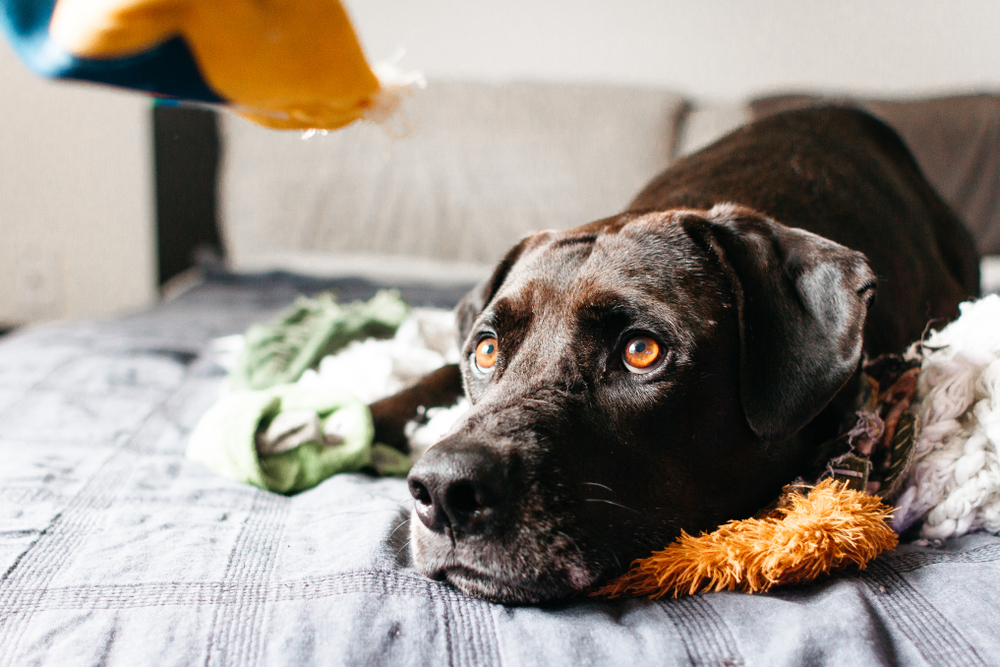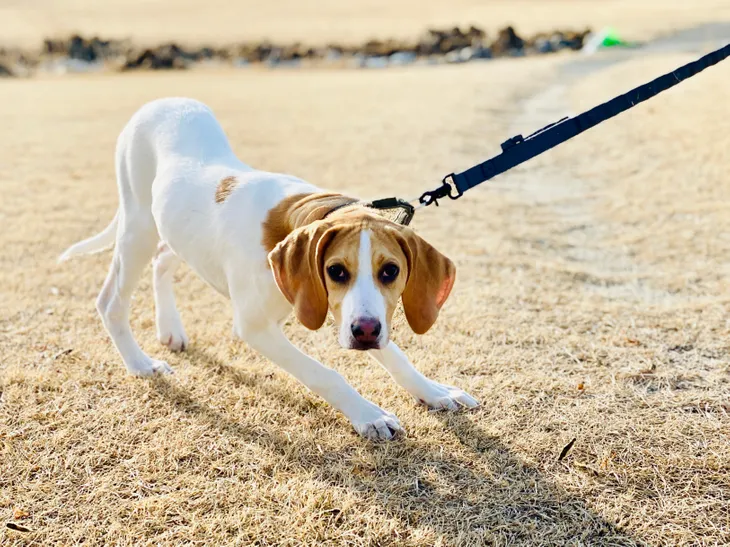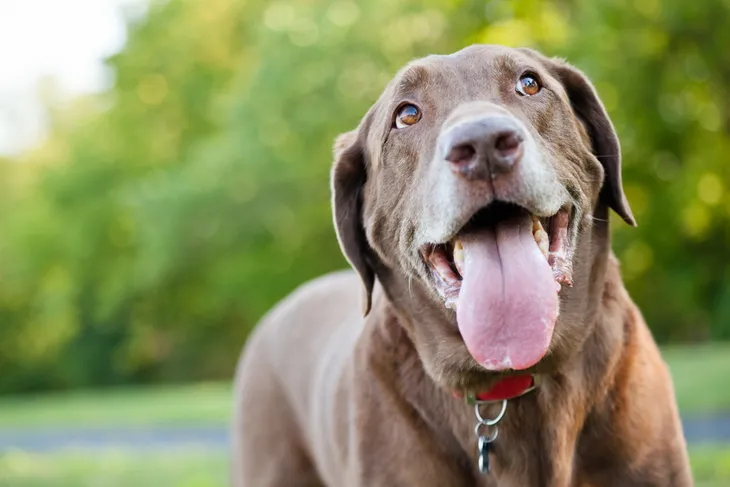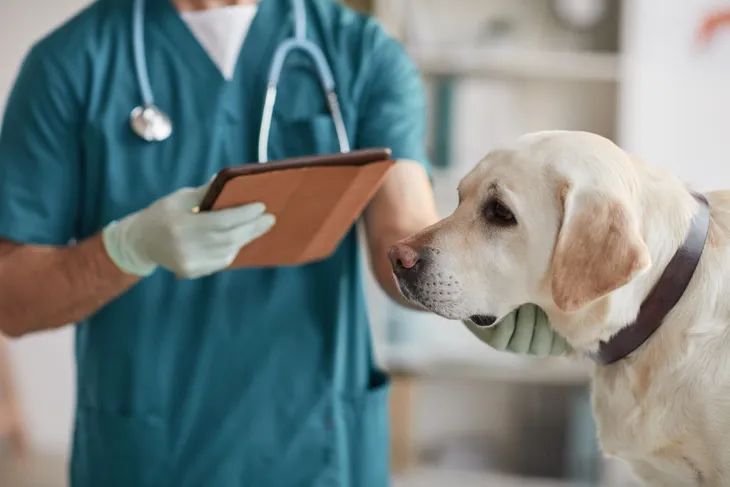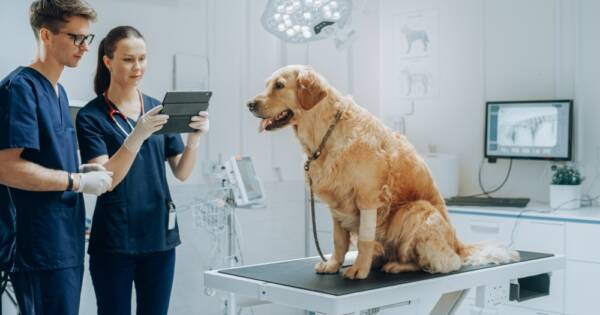- A dogs natural instinct is to hide their pain which makes it more difficult for owners to know when something is wrong.
- Some common indicators that a dog is in pain are behavioral and physical changes, increased vocalization, localized grooming, and changes in eating and drinking.
- If you suspect your dog is in pain, schedule an appointment with your veterinarian. They will do an assessment, run diagnostic tests, and hopefully pinpoint what the problem is.
One of the worst things for a pet owner is to see their animal in pain. You want to take their pain away and comfort them, but oftentimes it’s hard to even know what is causing their discomfort. It’s even more difficult because while we share a close bond with our pets, they can’t verbally communicate with us. They can’t tell us what’s wrong. At the end of the day, every dog is different, so it’s up to us to decipher any signs they might show us.
Whether it’s from an injury or an underlying health issue, a dogs first instinct is to hide their pain and suffer in silence. This is a natural instinct hardwired in them to protect against predators. Unfortunately, this stoic gesture works against owners who’s job it is to take care of them. Luckily, there are still some key warning signs to look for. Here’s a look at the most common signs your dog is in pain…
Whimpering and Whining
While dogs tend to hide their pain by masking physical symptoms, Cesars Way says they will vocalize it through whining, whimpering, yelping, growling, snarling, and even howling. This is especially true for young dogs who have not experienced much physical discomfort. Since it’s not always accompanied by physical action, it’s not easy for owners to pick up that something is wrong.
Our first reaction is to offer comfort. Just remember, if a dog stops whining, it doesn’t necessarily mean they aren’t in pain anymore. “Whimpering or increased vocalizations, which can be intermittent, constant, or when touched, can indicate pain. Just because your dog is not whimpering, does not mean he or she is not in pain,” says veterinarian Heidi Cooley, DVM, Chief of Staff at Banfield Pet Hospital when talking to Reader’s Digest.
Localized Grooming
Most pets keep up their own hygiene and grooming in the form of licking, but any excessive licking could be them trying to soothe themselves. “When a dog is hurt, its first instinct is often to clean and care for the wound by licking it,” writes VetsNow. Of course, a cut will be easily identifiable, but there are times when the pain is internal. In these cases, a dog might still try to lick the area in an effort to fix the problem.
Cesars Way also notes that dogs will lick their paws to rub their eyes if they are experiencing eye pain. Dog owners who notice signs of excessive grooming should notify their veterinarian.
Changes in Eating and Drinking
Changes in eating or drinking, particularly a loss in appetite, is a big indicator that something is wrong. Dogs aren’t like humans, they definitely don’t diet! They are quite regular with their eating and drinking habits, so a change to either of these is a red flag. “If your pup has never missed a meal, there is reason to be concerned about her turning up her nose to food and treats,” says veterinarian Meghann Robinson, DVM, MPH to Reader’s Digest.
They are similar to us in the sense that when we’re sick, we won’t eat or drink as much. Dogs are no different. If they’re eating and drinking less it’s likely because they are in pain or discomfort. “Difficulty eating, particularly dried food or firm chews, can indicate dental pain,” writes VetsNow.
Restlessness or Change in Sleeping Habits
Dogs are just like us in that when they are not feeling well, they need more rest! According to VetsNow, dogs that are in pain will likely sleep more as their bodies are trying to heal. They might also be resting more just because it’s difficult for them to move around or be active.
On the other hand, a dog that is restless, unable to sleep, or simply agitated could also be struggling with pain. They could be unable to get comfortable so they are just pacing back and forth, unable to sleep because they’re distracted by the pain. Depending on what’s wrong, lying down might cause them more discomfort. Any notable changes pertaining to more or less sleep are worth looking into.
Physical and Postural Changes
Physical changes are the easiest warning signs to notice, especially if you’re already tipped off by a change in their behavior. If you suspect your dog is in pain, look for physical clues on their body. Check for any swelling in their paws, legs, or face which could be caused by inflammation or even cancer, warns VetsNow.
In addition to swelling or lacerations, you might notice some changes in their posture. The same source adds that some dogs who are pain will assume a rigid or hunched stance, while others take on what’s called the “prayer” posture. They will have their front legs on the ground and their bum up in the air, stretching through their abdomen. “Dogs often take the ‘prayer’ position when they are suffering from abdominal pain as it allows them to stretch this area out,” writes VetsNow.
Mobility Issues
Similar to physical changes, mobility issues are a much more obvious warning sign because it has to do with the dogs ability to move around. PetMD explains that dogs who are injured or struggling with arthritis will be less active. They might limp, walk slower or even outright refuse to walk. They could also be reluctant to go up and down stairs, jump onto furniture (if that’s allowed in their household), as well as slow to get up or lie down.
Another indicator might be whether or not they want to exercise. Are they suddenly uninterested or even wary of walks? They might also just not be as active as usual. Use your best judgement to determine if your dogs behavior is normal. PetMD also notes that these signs can accompany other serious medical or behavioral problems, so be sure to discuss any changes with your veterinarian.
Shaking and Trembling
Shaking or trembling in dogs happens when they are cold, old, or just nervous. For example, my dog starts to tremble when she figures out she is going to the vet or groomer. That’s normal! This would be considered occasional shaking or trembling and owners can manage these situations on their own.
There’s a problem if this behavior becomes chronic or extreme. If you notice your dog is shaking and trembling for no apparent reason, it could be a sign they are in pain or indicate a serious health issue like poisoning, pancreatitis, or kidney disease. “Dogs who have swallowed large amounts of chocolate, mouldy compost, or sugar-free sweetener xylitol, for example, often suffer severe muscle tremors,” writes VetNow.
Decreased Social Interaction or Increase in Seeking Attention
Another good way to read into how a dog is feeling is by gauging how they react to you. There could be a decrease in their social interaction. For example, a dog that used to run and greet you at the door might stop and avoid contact. They could become antisocial, not wanting to be touched, or even aggressive.
However, it could also be the opposite. They might be over-friendly, giving or seeking out lots of physical affection and attention, more so than they usually do.
Aggressive Behavior
This one will vary based on the dog since some dogs are more aggressive by nature, but as the owner, you’ll be able to interpret whether this sudden aggression is something new. Just like us, dogs get cranky when they are in pain. But even more so, it’s part of their natural instinct to go into protection mode when they are in pain, notes Cesars Way. This is because they might think that you are going to hurt them. You might notice an even docile dog pin his ears back, growling, or even biting at times.
The symptoms above can be a sign that they are in pain, but it could also mean several different things. If it’s safe to do so and your dog isn’t acting aggressively, try to gently poke and prod around their body to see if they react sensitively to any specific area. This will help localize the pain, if there is any. Cesars Way warns to be careful when doing this because even docile dogs will sometimes bite if they get hurt when you touch a sore spot.
Heavy Breathing
Panting is normal for dogs that were recently active or in hot temperatures. Because dogs don’t sweat, panting is their way of keeping their bodies cool. What an owner should be watching for in this scenario is a dog who is panting for no apparent reason. If they are breathing heavily or panting and they haven’t been active or outdoors in the heat, it could be a sign of pain.
Also shallow breathing could be a sign that it hurts for them to take a breath. Preventative Vet advises taking note of any change in movement in the abdominal muscles and/or chest. Both muscles are involved in the breathing process.
Changes to Eyes
Most people wouldn’t think to look at their dogs eyes for indicators of pain, but they can tell us a lot. According to Cesars Way, dogs with eye pain will frequently squint. You might also notice their pupils are smaller. If the pain is in another part of their body, the opposite is true — their pupils will get bigger.
Depending on the injury or underlying issue, it could affect one or both eyes. You might notice they are pawing at their eye(s), dragging them along the carpet or furniture, or that they are blood shot, notes Preventative Vet. Issues that can affect dogs eyes are corneal abrasion, eyelid issues (entropion), glaucoma, conjunctivitis, or other obscure eye diseases, says Reader’s Digest.
What You Can Do To Help
Dogs cannot verbalize what is going on with them, so it’s up to us to advocate for them. First and foremost, make an appointment with your veterinarian who can help determine what the underlying problem is. They will do an assessment and might run some diagnostic tests like X-rays, blood tests, or even an ultrasound. In order to get a quick and efficient diagnosis, consider keeping a record of any physical and behavioral signs and changes. Try to include specific scenarios and even photo or video documentation.
The second thing PetMD suggests doing is stop or modify any physical activities with your pet. If they are showing signs of pain during or after activity, avoid it until speaking with your veterinarian. “Your veterinarian will be able to help you figure out how to best help your pet, whether it is stopping that activity altogether or establishing modifications that will minimize pain,” writes the source. These modifications might include a ramp, steps, shorter walks, or raising food and water dishes to a more comfortable height. It might be temporary, but for chronic pain they could be more long-term.
The last thing PetMD suggests is to explore all treatment options, from massages to medication and even surgery. And don’t be afraid to ask questions and get a second opinion.
